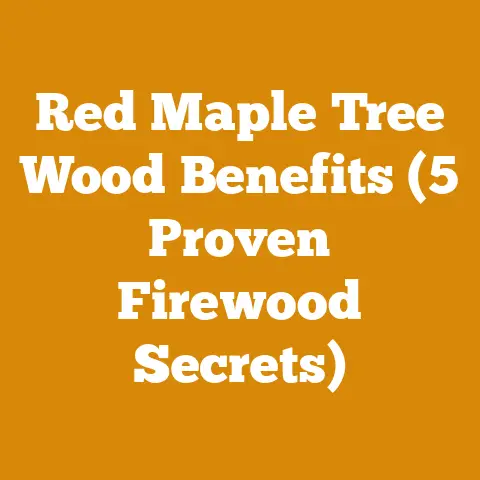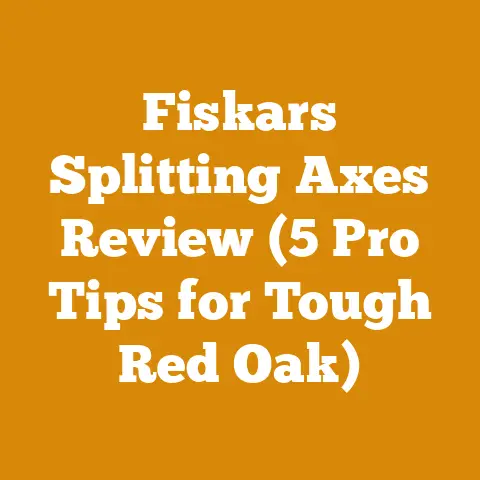How Much Is a Maple Tree Worth? (7 Expert Wood Value Tips)
I’ve spent years felling trees, milling lumber, and splitting firewood, so I know firsthand that determining the value of a maple tree isn’t as simple as just looking at its size. There are many factors at play, from the species of maple to its location and the current market demand. Understanding these factors is crucial, whether you’re a homeowner with a maple in your backyard, a small-scale logger, or simply someone who appreciates the beauty and utility of wood. My goal here is to equip you with the knowledge to accurately assess the worth of a maple, maximizing its value and minimizing potential losses. Let’s dive in!
The Importance of Cost-Effectiveness
Before we get into the nitty-gritty, let’s talk about cost-effectiveness. In the world of wood processing, every decision needs to be viewed through the lens of efficiency. Is it worth the effort to mill that tree into lumber, or would it be more profitable to sell it as firewood? Will the cost of hiring a professional arborist outweigh the potential value of the timber? These are the kinds of questions I always ask myself before even touching a chainsaw.
I remember one time, I had a massive silver maple that came down during a storm. My initial thought was to mill it into lumber for a barn project I was planning. However, after considering the cost of renting a portable sawmill, the time investment, and the risk of hidden defects in the wood, I realized it was far more economical to cut it into firewood and sell it locally. The lesson? Always weigh the costs against the potential benefits.
1. Identifying the Maple Species: Not All Maples Are Created Equal
The first step in determining a maple tree’s worth is identifying its species. Different maple species have different properties and therefore different values. Here’s a breakdown of some common types:
Its hard, dense wood is highly prized for flooring, furniture, and musical instruments. Sugar maple also produces the sap used to make maple syrup, adding another potential revenue stream.
How to Identify:
- Leaves: Sugar maple leaves have 5 lobes with rounded sinuses (the spaces between the lobes). Red maple leaves also have 5 lobes, but the sinuses are more pointed. Silver maple leaves have 5 deeply cut lobes with silvery undersides. Bigleaf maple leaves are, well, big – often exceeding 12 inches in width.
- Bark: Sugar maple bark is gray and develops deep furrows with age. Red maple bark is smoother and reddish-brown when young, becoming more furrowed with age. Silver maple bark is gray and often peels off in long strips.
- Twigs: Sugar maple twigs are brown and have sharp, pointed buds. Red maple twigs are reddish and have blunt buds. Silver maple twigs are slender and reddish-brown.
Data: The price difference between sugar maple and red maple lumber can be substantial. Sugar maple can fetch prices 20-50% higher than red maple, depending on grade and thickness.
2. Assessing Tree Size and Volume: Board Feet and Cord Calculations
Once you’ve identified the species, you need to determine the tree’s size and volume. This is typically done using two measurements: diameter at breast height (DBH) and tree height.
- DBH: Measured 4.5 feet above ground level. Use a diameter tape for accuracy.
- Tree Height: Estimate the height using a clinometer or by comparing it to a known object.
Calculating Board Feet:
Board feet are the standard unit of measure for lumber. A board foot is 1 inch thick, 12 inches wide, and 12 inches long. There are various formulas for estimating board feet based on DBH and height. Here’s a simplified version of the Doyle Log Scale, commonly used in the Eastern US:
Board Feet = (DBH - 4)^2 / 16 * Log Length (feet)
Example: A sugar maple with a DBH of 20 inches and a log length of 12 feet:
Board Feet = (20 - 4)^2 / 16 * 12 = (16)^2 / 16 * 12 = 256 / 16 * 12 = 16 * 12 = 192 board feet
Calculating Cords:
Cords are the standard unit of measure for firewood. A standard cord is a stack of wood measuring 4 feet high, 4 feet wide, and 8 feet long, totaling 128 cubic feet. Estimating cords in a standing tree is less precise than calculating board feet, but here’s a rough guideline:
- A tree with a DBH of 12 inches and a height of 40 feet might yield 0.5-1 cord of firewood.
- A tree with a DBH of 20 inches and a height of 60 feet might yield 1-2 cords of firewood.
Tool Specifications:
- Diameter Tape: Essential for accurate DBH measurements.
- Clinometer: Used to measure tree height accurately.
- Measuring Tape: For measuring log lengths and firewood stack dimensions.
Case Study:
I once had to estimate the firewood volume of a stand of mixed maple and oak trees. I used a combination of DBH measurements, height estimations, and visual inspection to determine the approximate cordwood yield. I then compared my estimate to the actual volume harvested, adjusting my calculations for future projects.
3. Evaluating Wood Quality: Defects, Rot, and Figure
The quality of the wood significantly impacts its value. Look for defects like:
- Rot: Soft, discolored wood indicating decay.
- Cracks and Splits: Reduce the structural integrity of the wood.
- Knots: Can lower the grade and strength of lumber.
- Insect Damage: Holes and galleries caused by insects.
- Figure: Unique grain patterns like curly, quilted, or bird’s-eye maple can significantly increase value.
Assessing Wood Quality:
- Visual Inspection: Examine the bark, trunk, and branches for signs of damage or decay.
- Sound Test: Tap the trunk with a hammer or axe. A hollow sound indicates rot.
- Increment Borer: A tool used to extract a core sample of wood for inspection.
Original Insight:
I’ve found that trees growing in stressed environments (e.g., compacted soil, drought conditions) are more prone to defects and rot. Conversely, trees growing in healthy, well-drained soil tend to produce higher-quality wood.
Data: Lumber grades are based on the presence and severity of defects. Higher grades fetch significantly higher prices. For example, FAS (First and Seconds) grade sugar maple can be twice as expensive as #2 Common grade.
4. Determining Accessibility and Logging Costs: The Logistical Equation
The ease of accessing and logging the tree is a critical factor in its overall value. Consider:
- Location: Is the tree located in a remote area or near a road?
- Terrain: Is the ground level or steep and rocky?
- Obstacles: Are there fences, power lines, or other obstacles that need to be avoided?
- Regulations: Are there any local ordinances or environmental regulations that restrict logging activities?
Logging Costs:
- Labor: The cost of hiring loggers or doing the work yourself.
- Equipment: Chainsaws, skidders, loaders, trucks.
- Transportation: The cost of hauling logs to the mill or firewood processor.
- Permits and Fees: Costs associated with obtaining logging permits.
Strategic Advantage:
I always try to minimize logging costs by planning the operation carefully, using efficient equipment, and working during favorable weather conditions. For example, felling trees in the winter when the ground is frozen can reduce soil disturbance and make it easier to move logs.
Example: A maple tree located deep in the woods with difficult terrain might be worth significantly less than the same tree located near a road, simply because the cost of logging and transporting it is higher.
5. Considering Market Demand and Pricing: Supply and Demand Dynamics
The current market demand for maple lumber and firewood plays a significant role in its value.
- Lumber Market: Check current lumber prices online or by contacting local sawmills. Prices fluctuate based on supply and demand.
- Firewood Market: Research local firewood prices by contacting firewood dealers or checking online marketplaces.
Factors Affecting Demand:
- Economic Conditions: A strong economy typically leads to higher demand for lumber and firewood.
- Housing Market: New home construction drives demand for lumber.
- Weather Patterns: Cold winters increase demand for firewood.
- Fashion and Trends: Certain wood species and grain patterns become popular in interior design.
Original Insight:
I’ve noticed that the demand for figured maple (curly, quilted, etc.) is often driven by trends in the musical instrument industry. When guitar makers are using a lot of figured maple, prices tend to rise.
Data: Lumber prices are tracked by various industry publications and websites, such as Random Lengths and the Weekly Hardwood Review. Firewood prices vary widely depending on location, species, and quantity.
6. Determining the Best Use: Lumber, Firewood, or Specialty Products
Once you’ve assessed the tree’s size, quality, and accessibility, you need to determine the most profitable use for it.
- Lumber: If the tree is of high quality and large enough to yield significant board feet, milling it into lumber may be the best option.
- Firewood: If the tree is of lower quality or difficult to mill, cutting it into firewood may be more profitable.
- Specialty Products: If the tree has unique figure or burls, it may be worth more as veneer, turning blanks, or other specialty products.
- Maple Syrup: For sugar maples, consider the potential for tapping the tree for syrup production.
Decision-Making Matrix:
| Factor | Lumber | Firewood | Specialty Products |
|---|---|---|---|
| Wood Quality | High (few defects, straight grain) | Low to Medium (some defects acceptable) | Exceptional figure or burls |
| Tree Size | Large (sufficient board feet yield) | Any size | Dependent on the size of the figure/burl |
| Accessibility | Good (easy to transport logs) | Medium to Good (can be processed on-site) | Good (smaller pieces, easier to transport) |
| Market Demand | High for specific grades and species | Consistent local demand | Niche market, potentially high value |
| Processing Costs | Higher (milling, drying, grading) | Lower (cutting, splitting, seasoning) | Variable (dependent on the product) |
Tool Specifications:
- Chainsaws: Stihl MS 261 (professional-grade for felling and bucking), Stihl MS 170 (lightweight for limbing).
- Axes: Gränsfors Bruks Splitting Axe (for splitting firewood), Wetterlings Small Hunting Axe (for limbing).
- Log Splitters: Hydraulic log splitter (25-ton capacity for efficient splitting).
- Portable Sawmill: Wood-Mizer LT15 (for milling lumber on-site).
Original Insight:
I’ve found that selling firewood in smaller quantities (e.g., bundles or wheelbarrows) can often fetch a higher price per cord than selling it in bulk. This is because people are willing to pay a premium for convenience.
Value Calculation Formula:
Estimated Value = (Volume x Market Price) - (Logging Costs + Processing Costs)
Example:
- Sugar maple with 200 board feet of lumber-grade wood.
- Current market price for sugar maple lumber: $3 per board foot.
- Logging costs: $100.
- Milling costs: $200.
- Drying costs: $50.
Estimated Value = (200 board feet x $3/board foot) - ($100 + $200 + $50) = $600 - $350 = $250
Scenario Analysis:
Run different scenarios to see how the value changes based on different assumptions. For example, what if the lumber price drops by 10%? What if the logging costs are higher than expected?
Negotiation Strategies:
When selling timber or firewood, be prepared to negotiate. Research market prices and know your bottom line. Highlight the quality of your wood and the value you are offering.
Personalized Story:
I once sold a large sugar maple to a local woodworker who specialized in making custom furniture. I knew the tree had exceptional figure, so I negotiated a price that was significantly higher than the standard lumber price. The woodworker was thrilled with the quality of the wood, and I was happy with the profit I made.
Key Terms and Concepts
- Green Wood: Freshly cut wood with a high moisture content.
- Seasoned Wood: Wood that has been dried to reduce its moisture content, making it more stable and easier to work with.
- Board Foot: A unit of measure for lumber, equal to 1 inch thick, 12 inches wide, and 12 inches long.
- Cord: A unit of measure for firewood, equal to a stack of wood measuring 4 feet high, 4 feet wide, and 8 feet long.
- DBH (Diameter at Breast Height): The diameter of a tree measured 4.5 feet above ground level.
- FAS (First and Seconds): The highest grade of lumber, with few defects.
- Figure: Unique grain patterns in wood, such as curly, quilted, or bird’s-eye.
Felling Techniques, Debarking Logs, Splitting Firewood
Felling Techniques:
- Assess the Tree: Check for lean, wind direction, and any obstacles in the felling path.
- Plan the Escape Route: Clear a path away from the falling tree at a 45-degree angle.
- Make the Notch: Cut a notch on the side of the tree in the direction you want it to fall. The notch should be about 1/3 of the tree’s diameter.
- Make the Back Cut: Cut from the opposite side of the tree, slightly above the notch. Leave a hinge of wood to control the direction of the fall.
- Wedge (if needed): Insert a wedge into the back cut to help push the tree over.
- Monitor the Fall: Watch the tree carefully as it falls and move away quickly.
Debarking Logs:
- Tools: Draw knife, spud, or debarking machine.
- Process: Remove the bark from the log to prevent insect infestation and speed up drying.
- Benefits: Easier to handle, less prone to decay, and improves the appearance of the wood.
Splitting Firewood:
- Safety Gear: Wear safety glasses, gloves, and sturdy boots.
- Stance: Stand with your feet shoulder-width apart and a firm grip on the axe.
- Swing: Raise the axe above your head and bring it down with force on the log.
- Hydraulic Splitter: For larger logs or increased efficiency, use a hydraulic log splitter.
Drying Methods:
- Air Drying: Stack the wood in a well-ventilated area, off the ground, and covered from rain.
- Kiln Drying: Use a kiln to dry the wood quickly and control the moisture content.
Safety Considerations:
- Identify the Maple Species: Practice identifying different maple species in your area.
- Assess Tree Size and Quality: Measure the DBH and height of maple trees and assess their wood quality.
- Research Market Prices: Check current lumber and firewood prices in your local area.
- Calculate Estimated Value: Use the value calculation formula to estimate the worth of maple trees.
- Start Small: Begin with a small-scale project, such as cutting firewood for personal use or milling lumber for a small woodworking project.
Conclusion
Determining the value of a maple tree is a multifaceted process that requires careful consideration of various factors. By understanding the species, size, quality, accessibility, market demand, and potential uses of the tree, you can make informed decisions about how to maximize its value. Whether you’re a homeowner, a small-scale logger, or simply someone who appreciates the beauty of wood, I hope this guide has provided you with the knowledge and tools you need to succeed. Now, get out there and start assessing those maples!






